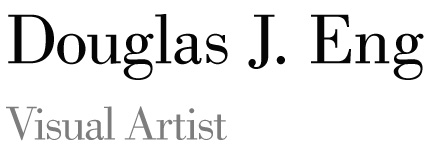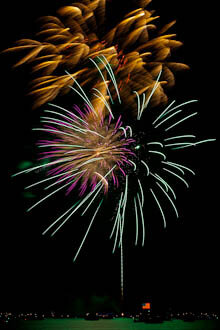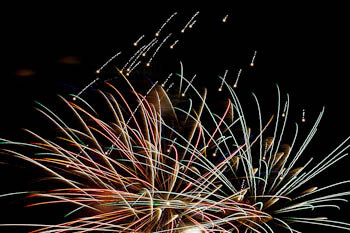July 4th is always a good holiday to divide up the year and reflect on what has happened and what is yet to come. I was fortunate to leave the heat and humidity of Jacksonville to spend a few days with Diana's in-laws and Dorian's brother in Ohio. We enjoyed fireworks on July 1 (an early tradition up here) and 3 days of continuous feasting. Being with family always has it's benefits.
Fireworks photography is always fun if you can find a decent spot and the weather cooperates. I regret all those summers I spent in Montreal and never photographed the International Fireworks Festival competitions...oh how I wished I was there for the summer. I experienced the fireworks at Buckeye Lake which is about 40 miles west of Columbus. They say the show is one of the best in the area and it did not disappoint. Almost 30 minutes of explosions. We were able to view them from a house on the lake, no long wait for a spot. After some dismal results with my 24-70 lens, I switched over to my 70-200 and went for some closer shots and details. Not having a clear view of the lake posed some challenges and I wasn't able to get many shots with the reflections in the water.
There are lots of articles on camera setup for fireworks (just Google "fireworks photography"). My settings were ISO 400, f/10, with an average 2 sec exposure. Cable release and tripod are essential. You want to be careful of not blowing out the highlights, so these settings depend somewhat on the distance you are from the show and the number of explosions happening at one time. Be prepared to adjust the ISO and aperture to account for this (check your histogram or flashing overexposure warning). Another convenient setting is to use your "B" mode and just count down the seconds. This gives you more control over when you want to stop the exposure, especially when you see another firework starting to enter the frame. I actually forgot about using "B" and many of my shots ended up with a new firework entering the frame, something to remember. I'm paranoid about focus, and since everything is pitch black you wonder what you should be focused on. You can pretty much go to infinity and just back off a tad. Shooting at f/8 or above will ensure that the lights will be in sharp focus.
While waiting for the show you can always play around with moving your camera on the surrounding lights. This will help you warm up and to get an idea of the exposure.
I post-processed all images in Lightroom and needed to increase the Blacks and Vibrance. Of course some cropping helps to isolate the patterns. I was thankful for the resolution on the 5D2, zooming in on some of the light trails revealed some very interesting patterns. Shooting tight with the telephoto gives a different perspective on the scene. I know that we get caught up in the grandeur of the big circular clouds, but try to isolate for a different look. The half hour show went by quickly. It's nice to have images to relive the moment.






